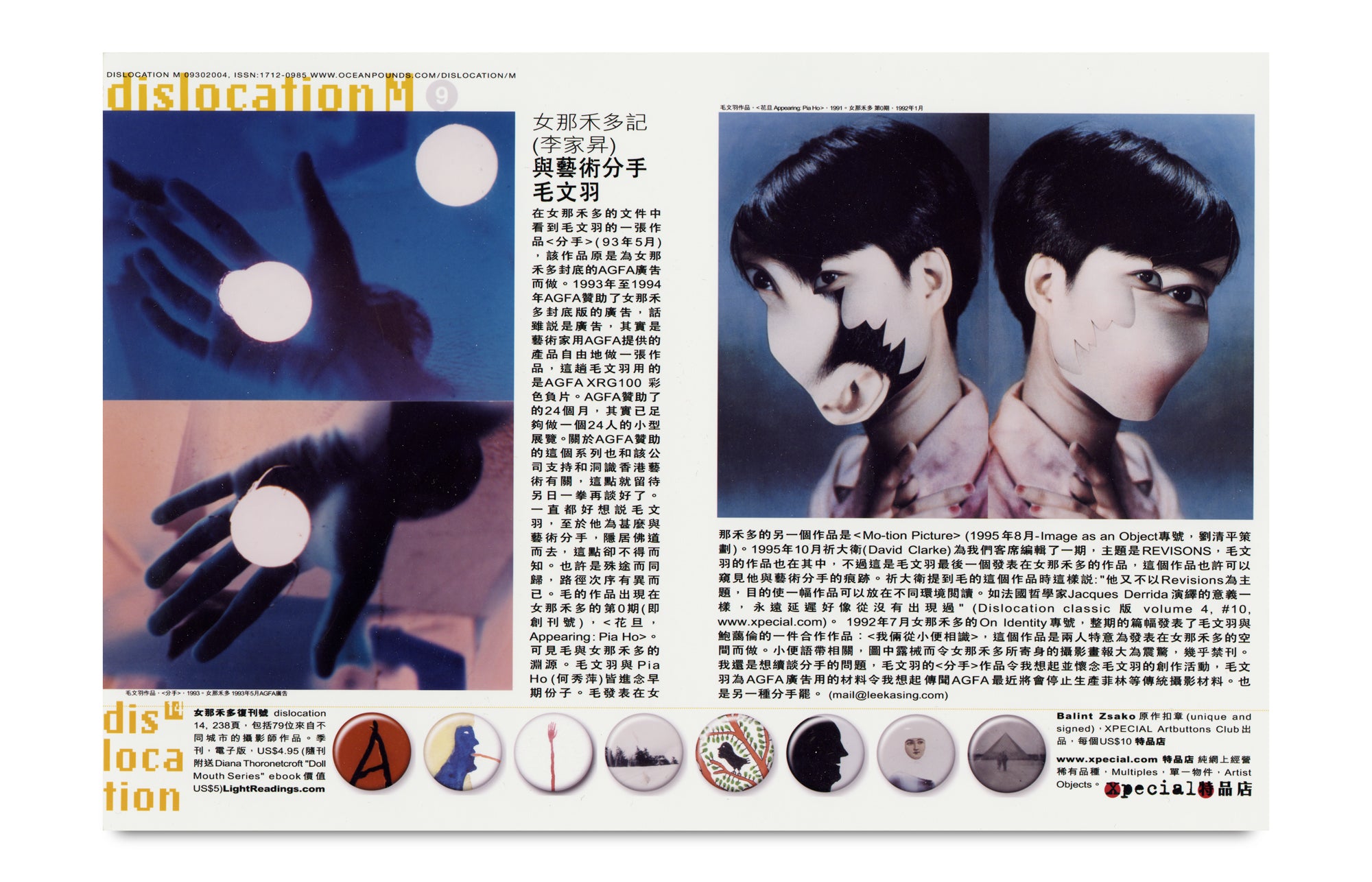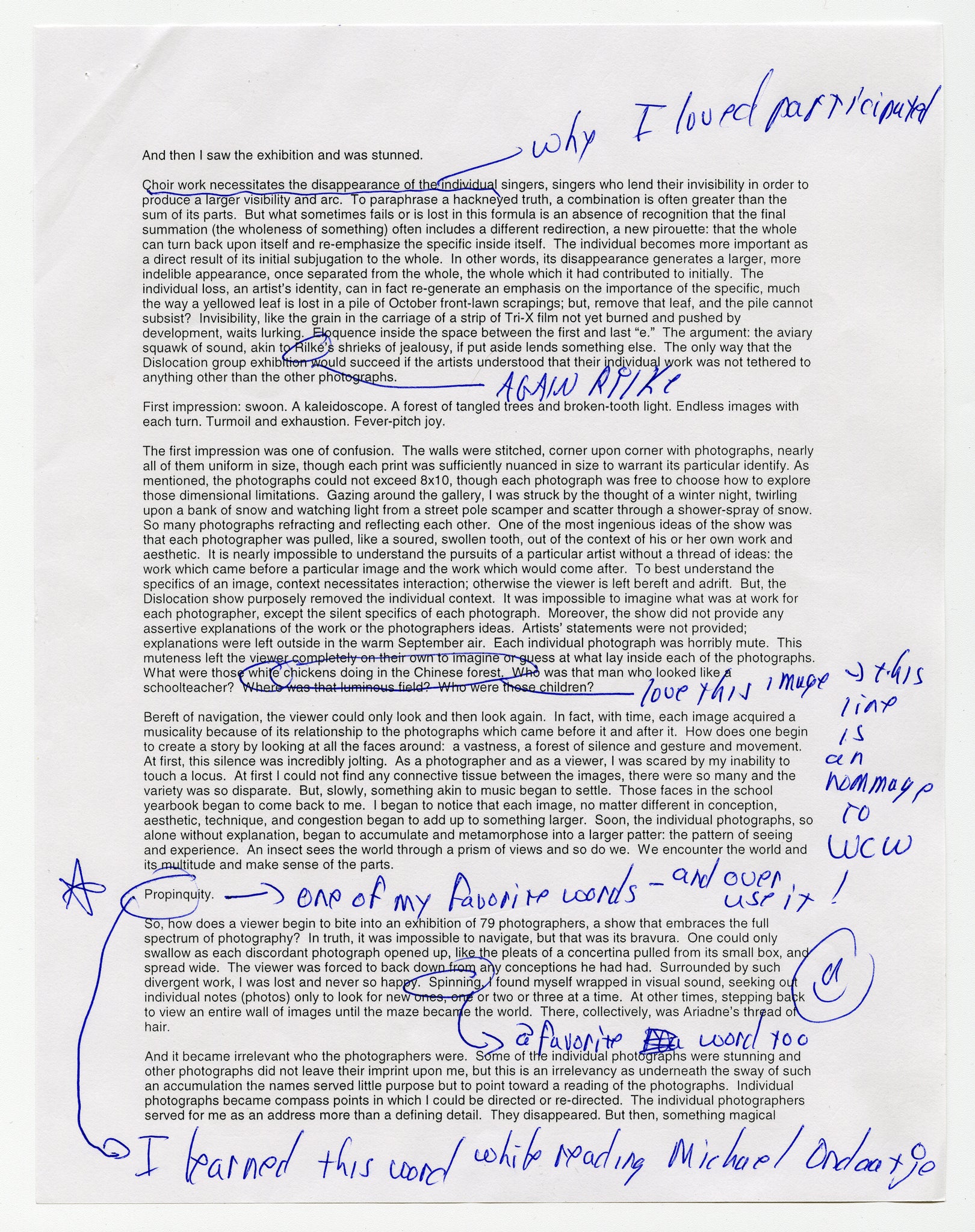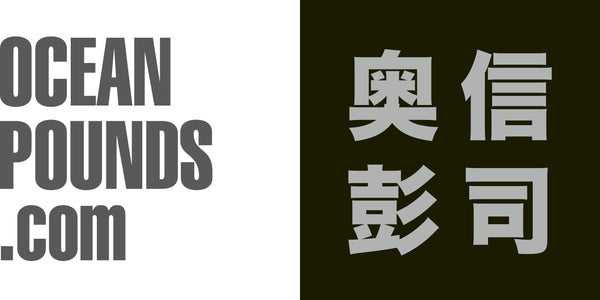
DOUBLE DOUBLE
A Holly Lee and Lee Ka-sing online magazine
Published on Fridays since January 2019
李家昇黃楚喬網上雜誌,逢星期五出版
Writings/ Photographs/ Poetry/ Archives
++++++++++++++++++++++++++
JUNGLE LINE
(NuNaHeDuo DISLOCATION, 3 of 3) A Life in Publication
written by Holly Lee

DISLOCATION Volume 14, PDF format, 119 pages, published in July 2004. Edited by NuNaHeDuo Centre of Photography
This side towards lens
The above paragraph was excerpted from an article I wrote about DISLOCATION in the July 2003 issue (Volume 1 #14) of FOTO POST. From 2003 to 2004 we had been publishing FOTO POST, a semi-monthly e-newsletter in PDF format. In the first year, there were mostly two to three pages in one issue, subsequently, when the contents grew more pages were added. Twenty three issues were published before we ceased production in September 2004. FOTO POST was also available then for free download. At that point in time, we were already steering towards digital publishing putting out a good number of e-books on photography. It was one of the reasons why DISLOCATION Volume 14 could reemerge as a new digital version.

FOTO POST, Volume one, number 14, 4 pages, July 15, 2003. Published by OCEAN and POUNDS.

Some of photography e-books we published in the early millennium.
At the end of 1999, Ka-sing and I had been busy moving between Markham and Toronto, getting ready to inaugurate our photo gallery in the Candy Factory Loft. We named it “OP fotogallery (Toronto)”, which literally was, an extension to the “OP fotogallery (Hong Kong)”. It was meant to facilitate as our base in North America, functioning as an associate of the Hong Kong gallery, with the major task of synchronizing activities between the two cities.
Apart from family reasons, our move from Hong Kong to Toronto was never about leaving. It was more about reaching out, to connect and interact with other parts of the world. To us, it was exciting as a continuation of what we had established in Hong Kong, moreover full of anticipation of what was to come. With the halting of NNHD in 1999, NCP and OP fotogallery in 2000, I must admit we were a bit lost and disheartened.
At the end of 2003, Sylvia Ng of PHOTO PICTORIAL approached Ka-sing for help, asking him to assist in rescuing the publication, as the signs were clear - the magazine's readership and advertising were both going downhill. Ka-sing suggested to rebrand the magazine, giving it a totally new look. Content-wise keeping only the on-photo-equipment section plus limited pages for amateur or salon photography. Consequently they agreed on the new approach, Ka-sing was given full autonomy to redesign the layout and provide major contents for the magazine. Tommy Li Kam-Fai, who did the cover of DISLOCATION ZERO issue eleven years ago, helped to redesign the Chinese type-face of PHOTO PICTORIAL. The revamped issue began from January 2004. In the event of celebrating the 40th Anniversary of PHOTO PICTORIAL, the redesigned magazine was launched with a party held at the Fringe Gallery, alongside the solo exhibition of anothermountainman. After the launch of the rebranded PHOTO PICTORIAL, someone mentioned that he could feel the spirit of NNHD there. That was true, since the ceasing of NNHD, the closure of NCP and OP, we placed our focus and gathered all reserved energy into refashioning PHOTO PICTORIAL, the vision, the vibe, the tenacity and character would certainly be projected there. 
The rebranded PHOTO PICTORIAL, With our assistance to rebrand the publication, resulting a total of 16 issues in one and half year. It began with issue 462 (January 2004) and ended with issue 477 (April 2005), which is also the last issue of PHOTO PICTORIAL.
Issue 462 - (COVER) Diana Thorneycroft, (INTERVIEW) anothermountainman, (PHOTO CHINESE) Xing Danwen, (PHOTO INTERNATIONAL) Diana Thorneycroft, (E-BOOK) Almond Chu, Toni Hafkenscheid. Issue 463 - (COVER) Mauricio Alejo, (INTERVIEW) Leung Chi-Wo, (PHOTO CHINESE) Yao Jui-Chung, (PHOTO INTERNATIONAL) Mauricio Alejo, (FOTO POST), (E-BOOK) Nobuyoshi Araki. Issue 464 - (COVER) Robert and Shana Parkeharrison, (INTERVIEW) Patrick Lee, (PHOTO CHINESE) B. Pollack on Chinese Photography. trans. (PHOTO INTERNATIONAL) Robert and Shana Parkeharrison, (FOTO POST), (E-BOOK) Hideo Suzuki, (OP CAFE) anothermountainman exhibition. Issue 477 - (COVER) Michael Awad, (PHOTO INTERNATIONAL) Michael Awad.
The major part of artwork of the new PHOTO PICTORIAL was produced in Toronto, with files saved in our server for the Hong Kong PP studio to download. On helping to revamp the magazine, the term Ka-sing gave was to have full autonomy of the contents, and both parties agreed to review the relationship after twelve months. The picture did not shine as bright as we'd expected. There were constant debates in the magazine among the old readers, some protested against the change and others favoured the reform. The worst thing was the publisher's lack of standpoint, short of a vision to introduce the publication to a broader, newer group of audience. After nine months, the publisher wished to replace some of the new contents with old materials. At the very end, the publisher only wanted to keep the monthly writing I produced on international photography, and the spread Contents Page designed by Ka-sing. Ka-sing ended the collaboration with PP in issue #477 (April 2005), which was also the last issue of the magazine. Someday I will write an individual piece focusing on this one and half year collaboration, which Ka-sing described as a post-NuNaHeDuo relationship with PHOTO PICTORIAL.
Crossing over
With the newly set up gallery in 2000, we met and acquainted a decent number of Canadian artists, some of whom later added to our gallery’s roster; P. E. Sharpe was one of them. The flame was always there, since we had already set up the digital platform, running our own servers and producing a number of photography e-books and ezines, the idea of creating a new, digital life for DISLOCATION was in view. We invited Sharpe to join our team, to work with the Hong Kong committee members Lau Ching-Ping, Patrick Lee, Blues Wong (we also suggested adding Janet Fong to our group) for the “DISLOCATION Re-launch issue”. We started by inviting a hundred photographers to partake, each to submit an image working around the theme of “dislocation”. Seventy nine artists had responded.
During Summer 2004, Ka-sing had an exhibition in the Hong Kong Heritage Museum. Titled FOODSCAPE it was a project in collaboration with Leung Ping-Kwan. This time they'd also invited Millie Chen, a Canadian Taiwanese as guest artist to put up a large scale installation of her work. Ka-sing was in Hong Kong for the whole month that Summer, and had brought P. E. Sharpe (who was our gallery artist then) and her solo exhibition to the Hong Kong Fringe Gallery. It was because of this background and occasion, came the idea of mounting simultaneously an exhibition in Hong Kong to celebrate the re-launch of DISLOCATION. The two openings opened with great fanfare, with Sharpe's show "unanswered: witness" on the main gallery, and “DISLOCATION Re-launch, 79 artists” in Volkswagen Fotogalerie on the second level of Fringe Club.


DISLOCATION RE-LAUNCH exhibition at Volkswagen Fotogalerie, Hong Kong. (top) Detail of the installation, exhibition designed by anothermountainman. (below) At opening reception. (from left) Image 1: - Evangelo Costadimas, Leung Chi Wo, Sara Wong, Norman Jackson Ford, David Clarke. Image 2 - Sabrina Fung, Millie Chen. Image 3 - Josiah Leung, Lau Ching-ping, Janet Fong, Lam Wai Kit, Bobby Sham.
In addition to this, there was a side story coming from the re-launch exhibition. After seeing the show, the editor of MILK, an innovative cultural magazine in Hong Kong, invited Ka-sing to write a column for MILK on the DISLOCATION stories. From August 2004 Ka-sing continued his literary account on visual culture linked closely with DISLOCATION. They were published weekly in MILK, and he named this column “DISLOCATION M”. Overall he wrote 39 pieces, insisting on his old habit to provide his own layouts. So for close to a year, every week MILK downloaded a finished artwork from our server.

Two vintage prints output directly from the files of Lee Ka-Sing’s DISLOCATION M column 女那禾多記 for MILK magazine. 303mmx202mm, c-type photographic paper (2004).
(top) Article “連環杜可風”, on Christopher Doyle. Doyle autographed this print when he was in Toronto on 11 September 2004. (below) Article “與藝術分手毛文羽”, on Mo Man-Yu.
Back in Toronto in September 2004 we ran the same “DISLOCATION Re-launch, 79 artists” in LEE Ka-Sing Gallery at the Candy Factory Loft. At the same time DISLOCATION volume 14 was launched as an e-zine (as PDF). Bob Black, painter, writer and photographer we met in Toronto, became a close friend. We'd invited him to participate as one of the artists in the Re-launch, and after seeing the show, he wrote a thoughtful essay for the exhibition. 
A vintage poster produced for the publicity of “DISLOCATION Re-launch, 79 artists” exhibition at LEE KA-SING gallery, Toronto. Poster size: 303mmx407mm, on c-type photographic paper (2004)

One page from the draft of a manuscript Bob Blak wrote about the DISLOCATION RE-LAUNCH exhibition at LEE KA-SING gallery, Toronto. The manuscript was recovered not until 2020 when we were gathering material for the "DOUBLE DOUBLE: Box-in-a-Valise" exhibition. In March 2021, we met Bob and told him about the manuscript, he was excited and enriched it with additional remarks using a ball pen in blue.
The full length manuscript is now archived at ON PHOTOGRAPHY -
https://oceanpounds.com/blogs/onphotography/dislocation
Landscape in flux
So much had happened in 2005, just when we were organizing work for a new issue for DISLOCATION (Volume 15, on GEOGRAPHY), we were hard at work on preparing for the Alternative Art Fair in New York. However, due to some unforeseen issues at the border, eventually we did not attend. The last quarter of 2005 was extremely stressful, but what took a really big bite of our strength was the decision to move from the Candy loft to another building, to 50 Gladstone Avenue. And perhaps this was the reason why DISLOCATION volume 15 never came out. Once we moved into the hundred-year old, three-storied building, our life was completely taken over and totally pushed into another direction. There was so much work, so much struggle that we had to put everything down and remain focus in overcoming what was needed most. It was also during this confusing period when DISLOCATION's new digital face faded out, bit by bit, and did not make its way back until I started to write about NNHD, and digging out photographs, paperwork and documents from the basement, until Ka-sing recovered DISLOCATION volume 14 as a pdf e-zine in his old hard disk, until a black box tagged “Geography” appears in front of our eyes (where the materials of Volume 15 was kept neatly inside); as compact discs containing images from photographers; as brief notes on the contents (written by me!); as editorial print-outs with marked instructions; as an article ‘“Escaping” written by P.E. Sharpe. How could something so concrete could be so largely forgotten, dislocated and dismissed? Why do we keep asking ourselves this question? Haven't we already learned memories are fragile, fallible, susceptible even to "deletion". Isn't this also a large part to do with our age, our difficult relationship and struggle with memory?
(Sometime after this paragraph was written, I discover at Ka-sing’s blog archive, his writings for MILK #33, a piece about the newly released DISLOCATION Volume 15. This "missing" volume included work by 11 artists, 168 pieces in three sections: 1. Urban and Suburban 城市與外城市; 2. Clockwise and Perpendicular 順時針與直角線; 3. Fugitive Geography 陣空地理學. As a consequence of the unfortunate break-down of our server and computer fifteen years ago, presently the digital copy of Volume 15 has not yet been found. Below is the link for Ka-sing writing on Volume 15 -
https://leekasing-dislocation.blogspot.com/2010/07/33.html
Recapturing time
The fragility of memory - no matter how true and serious this observation maybe, memories are the most precious and one of the few things we can claim in our essence of being. While I am roaming in my memory chamber contemplating the history of DISLOCATION, an exhibition is happening in Hong Kong, titled “New Horizons: Ways of Seeing Hong Kong Art in the 80s and 90s” (at HKMoA, Hong Kong Museum of Art). In the exhibition, among other artists and art groups, was a reconstruction of the physical space where the magazine (NNHD), the photography centre (NCP) and the photo gallery (OP fotogallery) once resided. This could happen thanks to the memories of Janet Fong, who guest curated the exhibition for the Hong Kong Museum of Art.

“New Horizons: Ways of Seeing Hong Kong Art in the 80s and 90s”, at HKMoA, Hong Kong Museum of Art. January 2021 to Spring 2022. (right upper corner) on left wall - Work by Blues Wong; right wall - work by Lau Ching-ping. (left lower corner) work by Holly Lee.
After I left Hong Kong, Janet Fong was appointed to work for OP fotogallery and NCP. A student of Blues Wong, freshly graduated from the Hong Kong Polytechnic University in Photographic Design, Janet got involved and immersed in the artistic atmosphere and practice of the 80’s and 90’s, during which time she matured, became well-versed in contemporary art, and when the right time came, stepped into a curator’s shoes.

The exterior of OP fotogallery, hong kong (1998-2001) located at Number 5 Prince Terrace, Hong Kong. Formerly the photo studio of Holly and Ka-sing.
In the “New Horizons: Ways of Seeing Hong Kong Art in the 80s and 90s” exhibition, two art spaces were re-created. In former years, these were the spaces where activities were held and art were exhibited. 1. - a cafe, an art installation created by its founding members in 1998 at Para Site (founded in 1996 as an active independent art institution); 2.- the OP fotogallery, a space where NNHD was organized, and NCP activities were shared. In the reconstructed space of OP fotogallery, each of the five committee member showed a piece, or a series of old work from the nineties. In the centre of the main gallery, a document cabinet is placed reminiscing on a past beloved table used for prints viewing, portfolios sharing, beer drinking, and sitting around it, discussions on photography brewing. On top of the cabinet a number of artifacts are on display.
In a way, Janet Fong was thinking fondly of a time past. She wants to unlock those memories, bringing them up close and personal, recreating certain facets of a former time to revisit. It is not too hasty to say then, by introducing this exhibition, she is also paying tribute to the artists that have influenced her ways of looking at art, and ultimately her path choosing art as a career. Memory is not only fragile, it is strong in reinvention, it changes every time upon recall, it adds and subtracts accordingly. The reconstruction of the OP space, therefore, is not and cannot be an exact replica, but an appropriation, after which, when the space is demolished, would become a new memory; and in the years to come, building up more sheets and layers, crushing and gnarling, a landscape in flux, a swirling maelstrom, an avalanche of flashbacks and anamnesis.
Thirty years
NNHD DISLOCATION was launched in 1992, approaching thirty next year, in 2022. In fact three decades wasn’t that long a time; but the more I think about it, the more it seems like yesterday. To younger generations who do not have such memory or just perching on the rim, the name DISLOCATION has become far more abstract, a legend, an imagination becoming a preoccupation. The word DISLOCATION, when first taken as an English name for NuNaHeDuo, was applied out of the feeling of displacement, of not belonging, rather than referring literally to distance or location. But after thirty years, it might be far more relevant to use the term today. For it does not need to take fifty years, not even thirty years for Hong Kong to submit to a totalitarian change. Within the space of twenty-seven years, free will weeded out, unfriendly, controlling winds send many people drifting, like seeds scattering out to different parts of the world, some soft landing, some hard, all dislocated. This leads us to think, what if we were able to restart a new chapter of DISLOCATION in 2022, wouldn't it be more about searching, and yearning for a real sense of belonging? An off-colour thought, an unintentional prophecy, a strangely familiar feeling creeping inside of me, insinuating an unsettling thought that the name DISLOCATION never sounds so right; and so timely.
++++++++++++++++++++++++++
DOUBLE DOUBLE
Issue 0402-2021
A Holly Lee and Lee Ka-sing online magazine. Published on Fridays since January 2019. Published by OCEAN POUNDS and archived at oceanpounds.com
All rights Reserved.
Click here to subscribe
If you are a researcher or writer and want to use the material, please write us in advance. Some of the materials might have different level of copyrights involved.
DOUBLE DOUBLE archives
https://oceanpounds.com/blogs/doubledouble
Holly and Ka-sing currently live in Toronto with their daughter Iris, and their cat Sukimoto. Contact with email at - mail@leekasing.com / holly@xpecial.com
++++++++++++++++++++++++++
